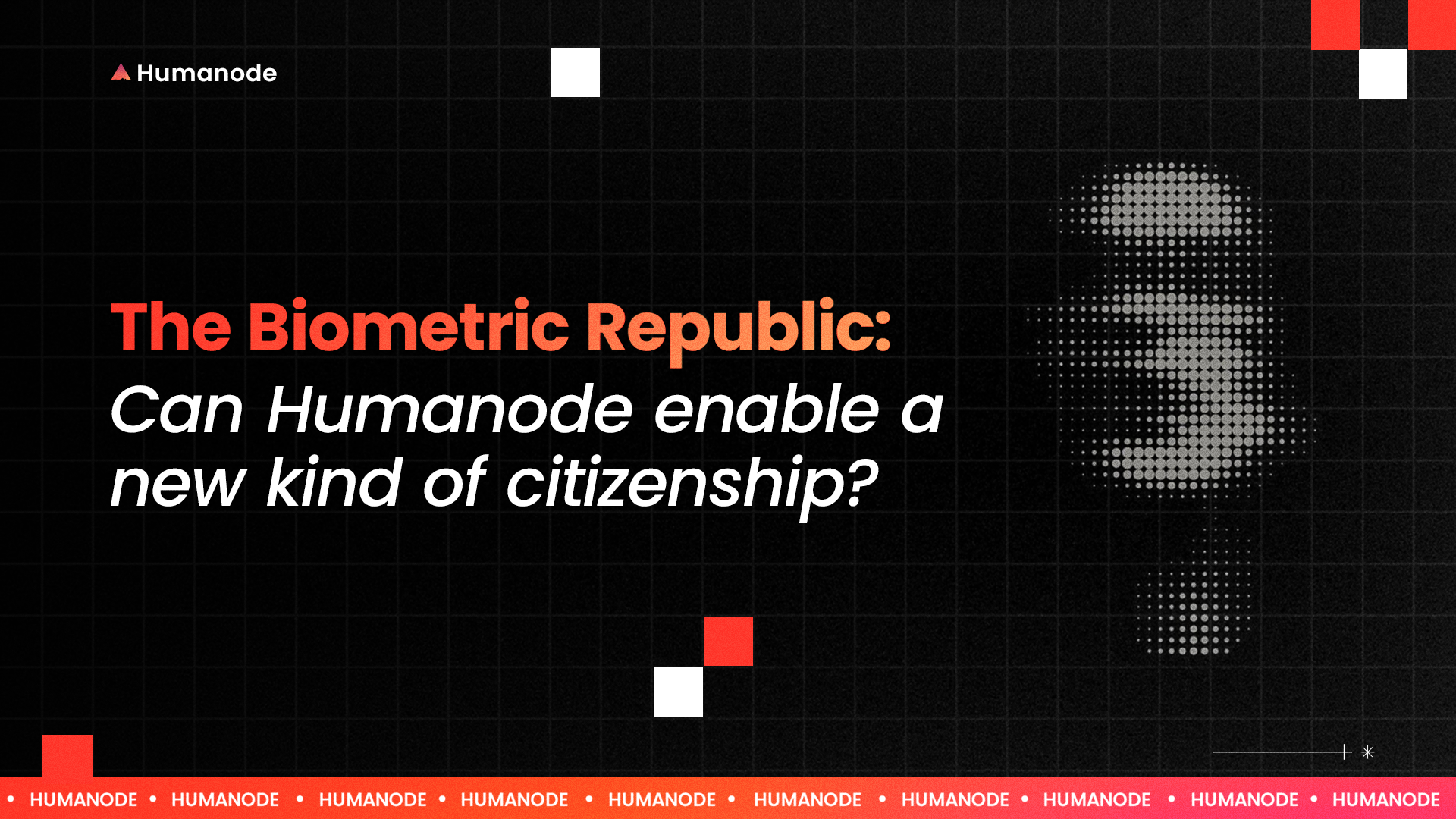The Biometric Republic: Can Humanode Enable a New Kind of Citizenship?

by Sasha Shilina
“We became aware of the existence of a right to have rights…” — Hannah Arendt, The Origins of Totalitarianism, 1951
I. Introduction
Citizenship is undergoing a quiet crisis. Around the world, millions are stateless, undocumented, or denied civic participation due to borders, economic disparity, or state violence. Digital platforms, meanwhile, increasingly govern access to labor, finance, expression, and community, yet lack any true model of citizenship. We are governed by platforms, not states, but we are not citizens of the cloud.
And yet, out of the cryptographic laboratories of Web3, a strange new possibility is emerging: a form of citizenship without nationhood, rooted not in documentation, but in biometric liveness, a universal proof that you are a unique, living human. This is the promise of Humanode.
Could this be the architecture for a new political formation, a biometric republic, where citizenship arises from presence, not passports?
II. A New Substrate for Identity
Humanode differs from most identity or Sybil-resistance solutions in three ways:
- Proof-of-Biometric-Uniqueness (PoBU) is based on liveness detection and biometric uniqueness, not social graphs or token staking.
- Crypto-biometrics’ infrastructure ensures that no raw biometric data is stored or shared. The system verifies you without knowing who you are.
- Consensus and governance are designed around the principle of “One Human = One Node = One Vote,” enabling egalitarian DAOs and systems not dominated by capital or botnets [1].
This infrastructure has deep implications beyond crypto security. It proposes a fundamental redesign of civic membership, where identity is verified by the body, but without reducing the individual to surveilled data.
What emerges is not just a security layer, but a citizenship layer.
III. Theoretical Foundations
Hannah Arendt famously defined citizenship as “the right to have rights” [2]. For her, statelessness was not merely a lack of a passport; it was the absence of recognition, of belonging to a political community that grants protection, visibility, and participation.
In the age of decentralized networks, DeFi, and DAOs, this Arendtian insight remains urgent. The digital world has replicated the exclusion of the analog: bots dominate influence, whales dominate votes, and identity remains a friction point.
Humanode reorients this by establishing a base layer of biometric recognition, not to identify who you are, but to affirm that you are someone: present, alive, singular. This recalls Étienne Balibar’s notion of “equaliberty”: that true liberty and equality cannot be separated, they must co-arise [3].
This new civic structure is:
- Borderless - not tied to nation-states.
- Anonymously inclusive - rejecting name-based identity, yet affirming singularity.
- Post-capital - resisting plutocratic governance structures.
- Civic by design - enabling rights and responsibilities through protocols, not paperwork.
It is not utopia. It is a design space.
IV. Layers of the Biometric Republic
The Biometric Republic is not a single application; it is a multi-layered ecosystem of tools for digital selfhood and collective belonging:
1. Biometric Core (Humanode)
- Each human being is granted one cryptographic node based on liveness.
- Biometric validation is zero-knowledge, ensuring privacy without pseudonymity collapse.
2. Self-Sovereign Identity (SSI) Integration
- With integrations into SSI systems, users can link verifiable credentials to their biometric identity, selectively revealing traits like age, affiliation, or role [4].
- This creates portable, composable identities that are not custodially held by states or platforms.
3. DAO-Based Belonging
- DAOs become civic entities: distributing resources, making decisions, executing policy.
- Humanode ensures equitable participation: not 1 token = 1 vote, but 1 human = 1 voice.
- Examples: a “DAO city” with governance rooted in Humanode ID, a borderless health cooperative, a global freelancer union with voting rights based on biometric presence.
In this system, citizenship becomes modular: verified by Humanode, enriched by SSI, expressed through DAOs.
V. Challenges Remain
Any redefinition of citizenship comes with existential risks, especially when the human body becomes the validator of truth.
• Exclusion through Biometrics
What happens to those with non-standard facial structures, injuries, or outdated devices? Biometric equity must be a design priority, not an afterthought.
• Biopolitical Capture
Though Humanode does not store personal data, the governance of biometric systems is a vital question. Who audits them? Who owns the infrastructure? Could states co-opt these tools?
• Post-Colonial Extraction
Many decentralized identity systems have been built in the Global North and deployed in the Global South, often without equitable governance. A Biometric Republic must not become a cryptocolonial apparatus.
• Civic Minimalism
Liveness is not enough. Citizenship is not only being, it is doing. Participation, deliberation, care, dissent, these must also be encoded into our cryptosocial architectures.
A real republic requires not only verification but recognition.
VI. The Future of Belonging
We might say that Humanode inaugurates a “protocolal citizenship”, a model of belonging that does not depend on central authorities, legal apparatuses, or fiat boundaries. Instead, it is sovereign-by-design, cryptographically enforced, and biopolitically minimal.
Its implications ripple:
- E-Residency 2.0: Humanode could form the substrate of post-national e-residency—used to vote, work, and transact across jurisdictions.
- Universal Basic Income (UBI) Experiments: If citizenship can be reliably tied to unique humans, universal basic income can be reimagined at a global scale, without fraud or gaming.
- Pluralistic Digital Nations: Instead of a single blockchain state, multiple DAO republics emerge, with overlapping memberships rooted in Humanode verification.
But this will require a new civic imagination, one that sees the validator not just as an economic agent, but as a political subject, capable of rights, duties, and care.
VII. Toward the Biometric Commons
Humanode is not a state. It is not a community. It is not a constitution.
But it may be the substrate upon which all three can be built, a skeletal layer of presence, on which identities, polities, and communities can form. It gives us proof of life, not as surveillance, but as sovereignty.
The Biometric Republic is not defined by where you are born, what passport you hold, or which cloud server remembers your name. It is defined by your presence in the network – your singularity, verified and ungoverned.
It is a citizenship that asks not who are you? but are you here? And in a time of deepening statelessness, automation, and digital disenchantment, that might be enough to begin again.
Footnotes
- Humanode. (2025). Whitepaper v2.1. https://whitepaper.humanode.io/
- Arendt, H. (1951). The Origins of Totalitarianism. Harcourt Brace.
- Balibar, É. (2014). Equaliberty: Political Essays. Duke University Press.
- Tobin, A., & Reed, D. (2016). The Path to Self-Sovereign Identity. https://sovrin.org/wp-content/uploads/2017/06/ThePathToSelfSovereignIdentity.pdf

